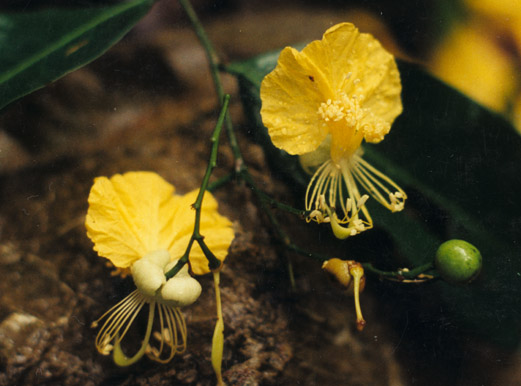Swartzia simplex (SW.) Sprengel
Fabaceae NARANJILLO
Occasional understory evergreen (10-15 m) tree of irregular and often asymmetrical form. Fully grown, Swartzia is an unremarkable tree, sporting a bole only 20 cm in diameter. Nevertheless, the beauty of its showy flowers and bright orange fruits compensate for the diminutive stature of this small tree. A versatile species, Swartzia thrives in the shady, primary forest understory as well as in the drier, brighter conditions of the secondary forest.
Description: Naranjillo has an angular and bending trunk with a circular cross section. Its bark is smooth and brown. Branches emerge from the upper half of the bole and produce a narrow crown whose thickness is strongly habitat dependent. Deep forest trees, receiving little direct sunlight, tend to possess thin crowns that are open and irregular in form. However, where insolation levels are higher, this species can develop a thick, symmetrical, and full canopy of leaves. Alternately arranged and appearing to be simple, Swartzia leaves in fact possess the reduced remnants of a second leaflet (0.5 cm) at the base of the petiole and are thus classified as compound. The blades of the principle leaflets (16 by 5 cm) are smooth, thick, and stiff. Of overall elliptical form, they vary in their degree of eccentricity, with some blades quite rounded but most others narrow and elongate. Dark green in color and possessing a fine network of secondary venation, leaflets may or may not sport short drip tips. Their margins curl downwards, forming a narrow, encircling lip. In drier sites, the distal fringes of the blades yellow, dry and chip away. About 20% of the foliage cover is renewed during each of a series of growth spurts that occur randomly during the year.
Swartzia flowers (4 cm) emerge from green, globular, seamless buds on long, terminal or subterminal racemes (6 cm). These yellow blossoms strongly resemble those of S. panamensis – possessing the same single, large, crinkled, superiorly positioned petal and segregated (upper and lower) stamen bunches. In addition, they also sport a long, flat and curling pistil. Delicate and ephemeral, Swartzia flowers appear in greatest abundance in May, with sporadic activity continuing into June and sometimes July. Fertility in this species occurs with nearly annual frequency, however occasional seasons are skipped.
Small fruits begin to grow immediately after flowering and persist on the trees for a minimum of six months before harvest. The bean-like pods (5 by 1.5 cm) are short, fat, and crisp, and possess pointed ends. Green and glossy while immature, they ripen by turning bright orange and splitting longitudinally. During this process, the pod walls curl back toward the pedestal and a single, curved, glossy, black seed (2.5 cm) is revealed. Dangling from the open fruit, these seeds are seen to be partially covered with an apron-like, white aril. Harvest begins in late November and lasts until January or sometimes February.
Similar Species: To identify sterile samples of Swartzia, look for the small, vestigial, wing-like secondary leaflet on the petiole, just below the main blade. Otherwise, the green or orange fruit pods persist in the canopy for the greater part of the year. While the flowers themselves can be easily confused with those of S. panamensis, those of S. simplex are short lived, do not occur in long, pendulous racemes, and appear mainly in May – one of the few months in which S. panamensis does not usually have blossoms.
Natural History: Swartzia flowers are pollinated by bees while its fruits are dispersed by aril-seeking avifauna. The flowering periods of the two Swartzia species present in Manuel Antonio appear to be precisely timed so that simultaneous blossoming never occurs. This observation invites speculation, especially since S. panamensis produces flowers virtually all year long – only stopping temporarily during May and June when S. simplex is active. Perhaps these species are so close genetically (as is evidenced by their nearly identical flowers) that cross-pollination and hybridization remains a possibility for them. The offspring of such a union would probably be sterile and the reproductive energy spent in their production them would thus be wasted. By dovetailing their flowering periods in this precisely timed way, these two Swartzia species may achieve the temporal isolation necessary to avoid this disadvantageous result.
Uses: Swartzia could be used as an ornamental tree – given its attractive blossoms, showy fruits, and ability to grow in a variety of habitats.
Distribution: This tree is found among the understory of the primary forest but perhaps preferentially along sunny streamsides. This species ranges from central Mexico to amazonian Brazil, Bolivia, and Peru.


